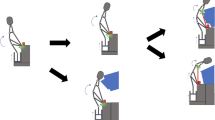Abstract
When a grasped object is in contact with an external environment, it is required to identify contact conditions prior to performing assembly tasks. The contact conditions include contact position, contact force, contact type, direction of contact normal, and direction of contact line between a grasped object and its environment. This article distinguishes soft-finger, line, and planar contact types in addition to point contact type. It is assured that these four contact types are distinguishable when the number of active force sensing samples is at least 6. Efficient algorithms for parameter identification and transition detection of contact conditions are explained. Effectiveness of our proposed method is verified through numerical examples.
Access this chapter
Tax calculation will be finalised at checkout
Purchases are for personal use only
Preview
Unable to display preview. Download preview PDF.
Similar content being viewed by others
References
Shimokura, K., Muto, S.: A Study of a Munipulation System with a Detection Module for Contact-state- transition. Journal of the RSJ 12(6), 837–845 (1994) (in Japanese)
Takano, K., Nakai, T., Sasaki, K.: Control Level Analysis of Primitive Motion of Handling Rectangular Solid. Journal of the JSPE 65(7), 1051–1055 (1999) (in Japanese)
Nakai, T., Sasaki, K.: Signal Processing of Active Force Sensing on Detecting Contact State. Journal of the Horological Institute of Japan 45(1), 16–26 (2001) (in Japanese)
Skubic, M., Voltz, R.A.: Acquiring Robust Force-Based Assembly Skills from Human Demonstration. IEEE Trans. on R. and A. 16(6), 772–781 (2000)
Takamatsu, J., Ogawara, K., Kimura, H., Ikeuchi, K.: Understanding of Human Assembly Tasks for Robot Execution (Generation of Optimal Trajectory Based on Transitions of Contact Relations). Journal of the RSJ 22(6), 752–763 (2004) (in Japanese)
Shutter, J.D., Bruyninckx, H., Durte, S., Geeter, J.D., Kaptupitiya, J., Demey, S., Lefebvre, T.: Estimating First-Order Geometric Parameters and Monitoring Contact Transitions during Force-Controlled Compliant Motion. The Int. Journal of Robotics Research 18(12), 1161–1184 (1999)
Lefebvre, T., Bruyninckx, H., Schutter, J.D.: Polyhedral Contact Formation Identification for Autonomous Compliant Motion: Exact Nonlinear Bayesian Filtering. IEEE Trans. on R. and A. 21(1), 124–129 (2005)
Meeussen, W., Rutgeerts, J., Gadeyne, K., Bruyninckx, H., Schutter, J.D.: Contact State Segmentation Using Particle Filters for Programming by Human Demonstration in Compliant Motion Tasks. IEEE Trans. on R. 23(2), 218–231 (2007)
Kitagaki, K.: Groping Motion and Manipulation. Journal of the RSJ 11(8), 1138–1142 (1993) (in Japanese)
Ishikawa, M.: Active Sensing and Robot Hand. Journal of the RSJ 11(7), 6–10 (1993) (in Japanese)
Salisbury, J.K.: Interpretation of Contact Geometries from Force Measurements. In: Proc. of 1st Int. Symp. Robotics Research, pp. 565–577 (1983)
Tsujimura, T., Yabuta, T.: Object Detection by Tactile Sensing Method Employing Force/Torque Information. IEEE Trans. on R. and A. 5(4), 444–450 (1989)
Zhou, X., Shi, Q., Li, Z.: Contact Localization using Force/Torque Measurements. In: Proc. of the IEEE ICRA, vol. 2, pp. 1339–1344 (1996)
Nagata, K., Tsumura, M., Omata, T.: Development of a Fingertip-type 6D Force Sensor and Error Evaluation of Contact Point Sensing. Journal of the RSJ 14(8), 1221–1228 (1996) (in Japanese)
Nagase, K., Yoshinaga, K., Nakashima, A., Hayakawa, Y.: Estimation of Contact Point by Force Sensor with Measurement Noise. Journal of the RSJ 23(6), 85–91 (2005)
Bicchi, A.: Intrinsic Contact Sensing for Soft Fingers. In: Proc. of the IEEE ICRA, vol. 2, pp. 968–973 (1990)
Murakami, K., Hasegawa, T.: Novel Fingertip Equipped with Soft Skin and Hard Nail for Dexterous Multi-fingered Robotic Manipulation. In: Proc. of the IEEE ICRA, pp. 708–713 (2003)
Murakami, K., Hasegawa, T.: Tactile Sensing of Edge Direction of an Object using a Robotic Fingertip with Soft Skin. Journal of the RSJ 24(2), 240–247 (2006) (in Japanese)
Kitagaki, K., Ogasawara, T., Suehiro, T.: Contact State Detection by Force Sensing for Assembly Tasks. In: Proc. of the IEEE Int. Conf. on Multisensor Fusion and Integration for Intelligent Systems, pp. 366–370 (1994)
Mimura, N., Funahashi, Y.: Parameter Identification of Contact Conditions by Active Force Sensing. Transactions of the JSME, Series C 60(579), 3816–3821 (1994) (in Japanese)
Mimura, N., Funahashi, Y., Mouri, T.: An Algorithm for Identification of Contact Conditions. Transactions of the JSME, Series C 63(610), 2061–2068 (1997) (in Japanese)
Yamada, T., Mouri, T., Mimura, N., Funahashi, Y.: Identification of Contact Conditions from Contaminated Data. Transactions of the JSME, Series C 64(618), 584–589 (1998) (in Japanese)
Mouri, T., Yamada, T., Mimura, N., Funahashi, Y.: Identification of Contact Conditions from Contaminated Data of Contact Moment. Transactions of the JSME, Series C 66(648), 2685–2692 (2000) (in Japanese)
Yamada, T., Mouri, T., Shimosaka, K., Mimura, N., Funahashi, Y.: Parameter Identification and Transitions Detection of Contact Conditions of a Robot by Active Force Sensing. Transaction of the JSME, Series C 74(747), 2721–2728 (2008) (in Japanese)
Mason, M.T., Salisbury, J.K.: Robot Hands and the Mechanics of Manipulation. MIT Press, Cambridge (1985)
Horn, R.A., John, C.R.: Topics in Matrix Analysis, pp. 170–181. Cambridge University Press, Cambridge (1991)
Author information
Authors and Affiliations
Editor information
Editors and Affiliations
Rights and permissions
Copyright information
© 2009 Springer-Verlag Berlin Heidelberg
About this chapter
Cite this chapter
Yamada, T., Mouri, T., Mimura, N., Funahashi, Y., Yamamoto, H. (2009). Identification of Contact Conditions by Active Force Sensing. In: Nguyen, N.T., Szczerbicki, E. (eds) Intelligent Systems for Knowledge Management. Studies in Computational Intelligence, vol 252. Springer, Berlin, Heidelberg. https://doi.org/10.1007/978-3-642-04170-9_12
Download citation
DOI: https://doi.org/10.1007/978-3-642-04170-9_12
Publisher Name: Springer, Berlin, Heidelberg
Print ISBN: 978-3-642-04169-3
Online ISBN: 978-3-642-04170-9
eBook Packages: EngineeringEngineering (R0)




